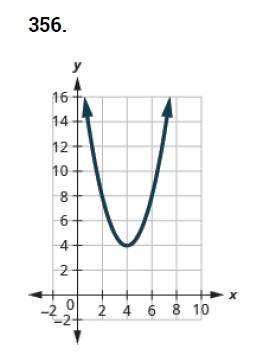Problem 9.105TI: a. Graph f(x)=x2,g(x)=x2+1, and h(x)=x21on the same rectangular coordinate system. b. Describe what... Problem 9.106TI: a. Graph f(x)=x2,g(x)=x2+6, and h(x)=x26 on the same rectangular coordinate system. b. Describe what... Problem 9.107TI: Graph f(x)=x25 using a vertical shift. Problem 9.108TI: Graph f(x)=x2+7 using a vertical shift. Problem 9.109TI: a. Graph f(x)=x2,g(x)=(x+2)2, and h(x)=(x2)2 on the same rectangular coordinate system. b. Describe... Problem 9.110TI: a. Graph f(x)=x2,g(x)=x2+5, and h(x)=x25 on the same rectangular coordinate system. b. Describe what... Problem 9.111TI: Graph f(x)=(x4)2 using a horizontal shift. Problem 9.112TI: Graph f(x)=(x+6)2 using a horizontal shift. Problem 9.113TI: Graph f(x)=(x+2)23 using transformations. Problem 9.114TI: Graph f(x)=(x3)2+1 using transformations. Problem 9.115TI: Graph f(x)=3x2. Problem 9.116TI: Graph f(x)=2x2. Problem 9.117TI: Rewrite f(x)=4x28x+1 in the f(x)=a(xh)2+k form by completing the square. Problem 9.118TI: Rewrite f(x)=2x28x+3 in the f(x)=a(xh)2+k form by completing the square. Problem 9.119TI: Graph f(x)=x2+2x3 by using transformations. Problem 9.120TI: Graph f(x)=x28x+12 by using transformations. Problem 9.121TI: Graph f(x)=3x2+12x4 by using transformations. Problem 9.122TI: Graph f(x)=2x2+12x9 by using transformations. Problem 9.123TI: (a) Rewrite f(w)=3x26x+5 in f(x)=a(xh)2+k form and (b) graph the function using properties. Problem 9.124TI: (a) Rewrite f(x)=2x2+8x7 in f(x)=a(xh)2+k form and (b) graph the function using properties. Problem 9.125TI: Write the quadratic function in f(x)=a(xh)2+k form whose graph is shown. Problem 9.126TI: Determine the quadratic function whose graph is shown. Problem 293E: In the following exercises, (a) graph the quadratic functions on the same rectangular coordinate... Problem 294E: In the following exercises, (a) graph the quadratic functions on the same rectangular coordinate... Problem 295E: In the following exercises, graph each function using a vertical shift. 295. f(x)=x2+3 Problem 296E: In the following exercises, graph each function using a vertical shift. 296. f(x)=x27 Problem 297E: In the following exercises, graph each function using a vertical shift. 297. g(x)=x2+2 Problem 298E: In the following exercises, graph each function using a vertical shift. 298. g(x)=x2+5 Problem 299E: In the following exercises, graph each function using a vertical shift. 299. h(x)=x24 Problem 300E: In the following exercises, graph each function using a vertical shift. 300. h(x)=x25 Problem 301E: In the following exercises, (a) graph the quadratic functions on the same rectangular coordinate... Problem 302E: In the following exercises, (a) graph the quadratic functions on the same rectangular coordinate... Problem 303E: In the following exercises, graph each function using a horizontal shift. 303. f(x)=(x2)2 Problem 304E: In the following exercises, graph each function using a horizontal shift. 304. f(x)=(x1)2 Problem 305E: In the following exercises, graph each function using a horizontal shift. 305. f(x)=(x+5)2 Problem 306E: In the following exercises, graph each function using a horizontal shift. 306. f(x)=(x+3)2 Problem 307E: In the following exercises, graph each function using a horizontal shift. 307. f(x)=(x5)2 Problem 308E: In the following exercises, graph each function using a horizontal shift. 308. f(x)=(x+2)2 Problem 309E: In the following exercises, graph each function using transformations. 309. f(x)=(x+2)2+1 Problem 310E: In the following exercises, graph each function using transformations. 310. f(x)=(x+4)2+2 Problem 311E: In the following exercises, graph each function using transformations. 311. f(x)=(x1)2+5 Problem 312E: In the following exercises, graph each function using transformations. 312. f(x)=(x3)2+4 Problem 313E: In the following exercises, graph each function using transformations. 313. f(x)=(x+3)21 Problem 314E: In the following exercises, graph each function using transformations. 314. f(x)=(x+5)22 Problem 315E: In the following exercises, graph each function using transformations. 315. f(x)=(x4)23 Problem 316E: In the following exercises, graph each function using transformations. 316. f(x)=(x6)22 Problem 317E: In the following exercises, graph each function. 317. f(x)=2x2 Problem 318E: In the following exercises, graph each function. 318. f(x)=4x2 Problem 319E: In the following exercises, graph each function. 319. f(x)=4x2 Problem 320E: In the following exercises, graph each function. 320. f(x)=x2 Problem 321E: In the following exercises, graph each function. 321. f(x)=12x2 Problem 322E: In the following exercises, graph each function. 322. f(x)=13x2 Problem 323E: In the following exercises, graph each function. 323. f(x)=14x2 Problem 324E: In the following exercises, graph each function. 324. f(x)=12x2 Problem 325E: In the following exercises, rewrite each function in the f(x)=a(xh)2+k form by completing the... Problem 326E: In the following exercises, rewrite each function in the f(x)=a(xh)2+k form by completing the... Problem 327E: In the following exercises, rewrite each function in the f(x)=a(xh)2+k form by completing the... Problem 328E: In the following exercises, rewrite each function in the f(x)=a(xh)2+k form by completing the... Problem 329E: In the following exercises, rewrite each function in the f(x)=a(xh)2+k form by completing the... Problem 330E: In the following exercises, rewrite each function in the f(x)=a(xh)2+k form by completing the... Problem 331E: In the following exercises, rewrite each function in the f(x)=a(xh)2+k form by completing the... Problem 332E: In the following exercises, rewrite each function in the f(x)=a(xh)2+k form by completing the... Problem 333E: In the following exercises, rewrite each function in the f(x)=a(xh)2+k form by completing the... Problem 334E: In the following exercises, rewrite each function in the f(x)=a(xh)2+k form by completing the... Problem 335E: In the following exercises, rewrite each function in the f(x)=a(xh)2+k form by completing the... Problem 336E: In the following exercises, rewrite each function in the f(x)=a(xh)2+k form by completing the... Problem 337E: In the following exercises, rewrite each function in the f(x)=a(xh)2+k form by completing the... Problem 338E: In the following exercises, rewrite each function in the f(x)=a(xh)2+k form by completing the... Problem 339E: In the following exercises, rewrite each function in the f(x)=a(xh)2+k form by completing the... Problem 340E: In the following exercises, rewrite each function in the f(x)=a(xh)2+k form by completing the... Problem 341E: In the following exercises, rewrite each function in the f(x)=a(xh)2+k form by completing the... Problem 342E: In the following exercises, rewrite each function in the f(x)=a(xh)2+k form by completing the... Problem 343E: In the following exercises, rewrite each function in the f(x)=a(xh)2+k form by completing the... Problem 344E: In the following exercises, rewrite each function in the f(x)=a(xh)2+k form by completing the... Problem 345E: In the following exercises, rewrite each function in the f(x)=a(xh)2+k form by completing the... Problem 346E: In the following exercises, rewrite each function in the f(x)=a(xh)2+k form by completing the... Problem 347E: In the following exercises, rewrite each function in the f(x)=a(xh)2+k form by completing the... Problem 348E: In the following exercises, rewrite each function in the f(x)=a(xh)2+k form by completing the... Problem 349E: In the following exercises, math the graphs to one of the following functions: (a) f(x)=x2+4 (b)... Problem 350E: In the following exercises, math the graphs to one of the following functions: (a) f(x)=x2+4 (b)... Problem 351E: In the following exercises, math the graphs to one of the following functions: (a) f(x)=x2+4 (b)... Problem 352E: In the following exercises, math the graphs to one of the following functions: (a) f(x)=x2+4 (b)... Problem 353E: In the following exercises, math the graphs to one of the following functions: (a) f(x)=x2+4 (b)... Problem 354E: In the following exercises, math the graphs to one of the following functions: (a) f(x)=x2+4 (b)... Problem 355E: In the following exercises, math the graphs to one of the following functions: (a) f(x)=x2+4 (b)... Problem 356E: In the following exercises, math the graphs to one of the following functions: (a) f(x)=x2+4 (b)... Problem 357E: In the following exercises, write the quadratic function in f(x)=a(xh)2+k form whose graph is shown. Problem 358E: In the following exercises, write the quadratic function in f(x)=a(xh)2+k form whose graph is shown. Problem 359E: In the following exercises, write the quadratic function in f(x)=a(xh)2+k form whose graph is shown. Problem 360E: In the following exercises, write the quadratic function in f(x)=a(xh)2+k form whose graph is shown. Problem 361E: Graph the quadratic function f(x)=x2+4x+5 first using the properties as we did in the last section... Problem 362E: Graph the quadratic function f(x)=2x24x3 first using the properties as we did in the last section... format_list_bulleted




